Beaches are one of our favourite destinations. Nothing compares to soaking in the warm sun, inhaling fresh ocean breezes and salty air. Just outside Jacksonville, on Big Talbot Island, “Boneyard Beach” is a fascinating place. A unique beach unlike any we’ve seen before!

Far from a conventional sandy retreat, ‘Boneyard Beach’ invites contemplation and reflection as weathered skeletons of ancient trees rise from the sandy canvas. But what is the story behind this captivating tableau? What forces conspire to create this unique phenomenon, and what hidden tales do these bleached remains have to tell?
This post may contain affiliate links, meaning if you purchase something through one of these links, we may earn a small commission at no extra cost to you! Read the full disclosure policy here.

Table of Contents
Finding Your Way to Boneyard Beach: A Guide to Reaching this Natural Masterpiece
An easy day trip from Orlando. From Jacksonville area, driving from Jacksonville beach, the trail parking lot is just a short 10-minute drive from the St. Johns River ferry.

North Access: You can access the beach in Big Talbot State Park just south of Amelia Island on A1A. A mile south of the George Crady Bridge and Fishing Pier, you will find the turn out. From North of Jacksonville, it is right off FL 105/A1 A.
Exploring Natural Beauty: Big Talbot Island State Park
In 1735, General James Oglethorpe named the islands after the honourable Charles Baron Talbot, Lord High Chancellor of England. The undeveloped barrier island became a state park in 1984, a part of Timucuan Ecological and Historic Preserve. A natural preserve, this barrier island offers access to diverse habitats, including Blackrock Trail to the shoreline, Big Pine Trail to the marsh, and Old King’s Highway through the maritime hammock forest. The park is a nature lover’s paradise. Recreational activities include hiking, bicycling, fishing, boating, canoeing, kayaking, and picnicking.
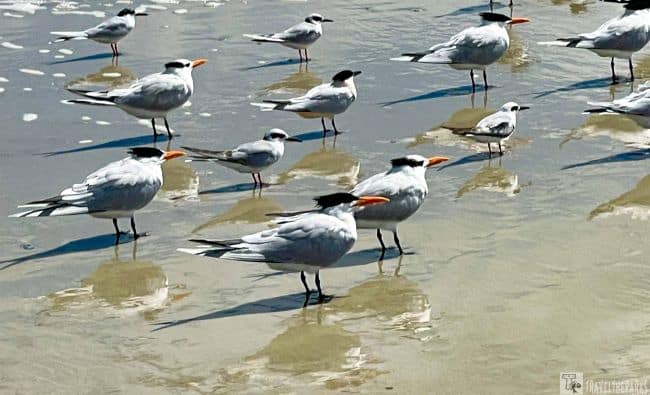
The park is a critical nesting habitat for both resident and migratory birds. Birdwatchers can spot protected species such as Royal tern, black skimmer, gull-billed tern, least tern, piping plover, American oystercatcher and red knot. The parks beaches are also prime turtle nesting habitat. Big Talbot Island State Park is open daily 8 am until sunset. For information, call (904) 251-2320.
Essential Items for Your Boneyard Beach Adventure
If you plan to spend the day, pack plenty of water, snacks, sunscreen, bug spray, sunglasses, beach towels, and remember your camera.

Boneyard Beach: Unraveling the Mystery Behind the Name
It’s easy to see why it’s called boneyard beach. The magnificent scenery of many gigantic skeletons of petrified old oak and cedar trees lay scattered along the beach. Sun-bleached by the elements of windblown sand and heavy surf has removed the bark and exposed the roots. This wild landscape of natural shifting sands and exposed trees appears otherworldly.
Note: Check the tides. Low tide is by far the best time to explore. High tide makes access to parts of the beach much more difficult.

Trail Access to Boneyard Beach: Your Pathway to a Unique Natural Wonder
Both the Bluffs Picnic Area and Blackrock Beach Trail will gain you access to the beach. Upon entering Big Talbot Island State Park, head to the Blackrock Trail parking area. This is the starting point for your hike to Boneyard Beach. The trailhead is well-marked, and you’ll find informational signs that guide you.
There is a self-pay parking fee of $3 per vehicle. You can place the honor system envelope into the boxes provided at each trail location. Most Florida’s state parks go by the honor system, please, be honest.

Bluffs Picnic Area: A Scenic Oasis on Big Talbot Island
At the Shoreline Access trail, the beach is easily accessible via a 0.25-mile trail from the parking lot. We recommend hiking shoes for the trail through dense underbrush. It meanders through saw palmetto and scrub oak before reaching the beach. Nowhere else is the erosion more noticeable than here. The sculpted 30-foot bluffs require a short scramble to reach the shoreline. Adventuresome as we are, we made our way down the embankment. We were immediately awestruck by the white sand beach lined with endless trunks of trees. The trees, even in death, protect the beach. They provide a buffering effect from the constant pounding Atlantic surf.
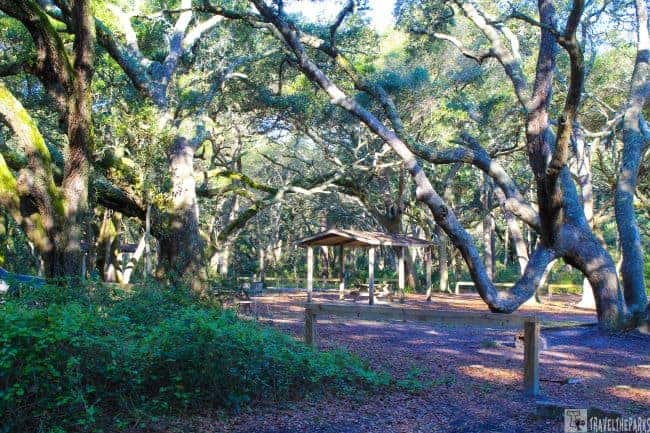
TIP: Don’t forget to bring your bug spray! For maximum protection, use it in combination with permethrin-treated clothing.
I recommend heading south down the beach. We walked for about 1.5-miles relishing the isolation and solitude. There are gorgeous views of Nassau sound. In this natural setting devoid of oceanfront condos, the beach seems endless.

At certain times of the year, the beach area may close for nesting sea turtles or birds. Be respectful of the warning signs. After walking the beach, we enjoyed a picnic lunch at one of the island’s shaded bluff pavilions.

Note: There are no facilities at Boneyard Beach and you can’t swim at this driftwood beach.
Black Rock Beach: Discover the Charms of these Islands Coastal Gem
The Black Rock trail turn out has limited parking. This trail is approximately 0.8 miles long and takes you through a maritime forest and coastal landscape. The sandy trail is a 10-minute hike. Currently, there is a habitat reclamation project being completed. Opening the dense forest made it easier to spot birds and deer. We arrived at the water’s edge, which is lined with what appeared to be black volcanic rocks. Upon closer evaluation, we found the rocks are actually the compressed remains of decayed roots, trunks and branches forming a hardened black muck. Called spodosol, they were squishy and slippery between our toes.

The “rocks” form small tidal pools brimming with sea creatures. Exploring them, we found small crabs and colorful little snails frequent the pools. A lone angler on the point was fishing, the only other person we saw on the beach.
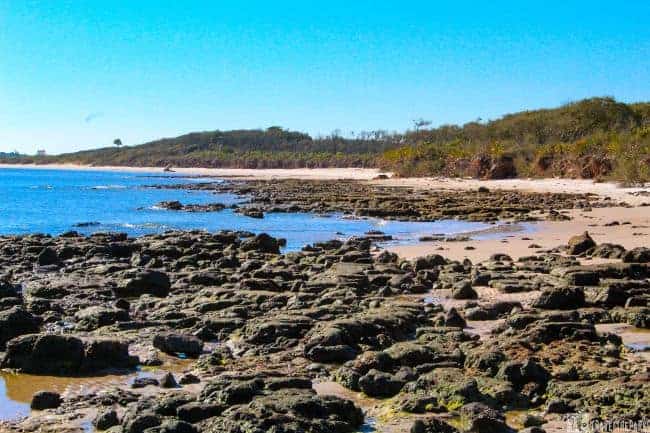
Exploring the Big Pine Trail of Big Talbot Island
This 0.8-mile trail traverses through maritime hammock forest. The trail leads to a bluff overlooking the estuary with excellent views of Simpson Creek and the salt marsh grasses.

Journey Through Time: The Jones Cut Trail (Old King’s Highway Trail) of Big Talbot Island
The old jeep road is on the west side of A1A. A 1.5-mile multi-use trail is popular with off-road bike riders. Maritime hammock forest of tall red bay trees, live oak and southern magnolia shade the trail. Bicycles are available for hourly and daily rentals from nearby concessionaires.
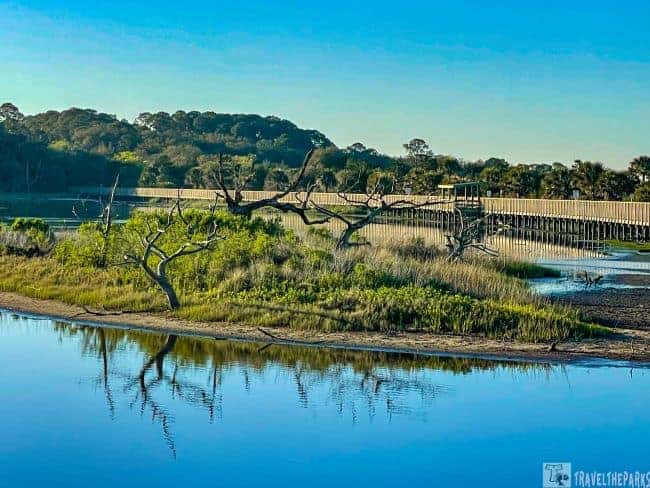
Rediscovering History and Nature: Timucuan Trail of Big Talbot Island
This is a 6.3 mile paved path runs alongside the park’s main road (A1A). Starts at Spoonbill pond, and ends at the Big Pine trailhead on the southern tip of Talbot Island. Frequented by bikers, equestrians and walkers alike. Interpretive panels along much of the boardwalk/path explain the many natural and cultural aspects of the park.

Spoonbill Pond is on the first stop on northeast end of Big Talbot. We parked at the Sawpit Creek boat ramp walking across the road to the elevated observation boardwalk. This vantage point is an excellent spot for sighting the different bird species that frequent the pond. The diversity seen here included white pelican, roseate spoonbill, wood storks, snowy egrets, osprey, and a colorful painted bunting. It was low tide and many wading birds were feeding on bait in the shallow waters. A small pod of white pelicans moved across the pond, feeding. With no wind, it reflected a mirror image of the herons and egrets standing in the water.

The beach area was closed for nesting gulls, so we walked under the bridges to the salt-marsh side. Returning to the parking lot, we watched an immature eagle dive from a large pine down over Spoonbill pond, trying to capture a cormorant for breakfast. It was fascinating watching him try to outsmart the cormorants, to no avail. He resumed his spot in the large pine directly above our vantage point.
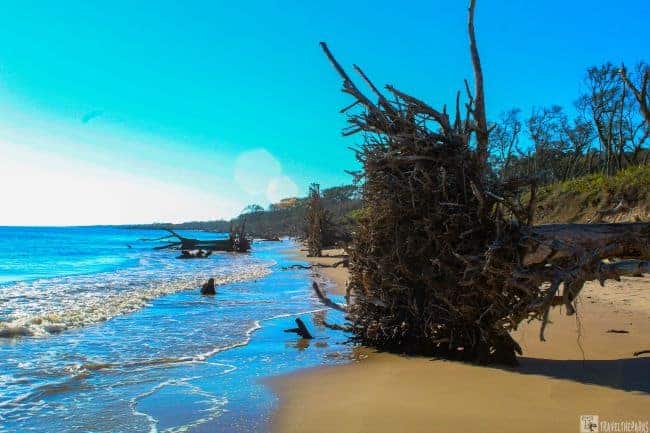
Big Talbot Island: Embraces Adventure on the Water
For those that prefer a water-based adventure in the park, consider renting a kayak at Kayak Amelia (the park concessionaire). They offer guided tours of the marsh estuaries, providing a unique perspective of the park. Miles of paddle trails include both Myrtle Creek and Simpson’s Creek. If you’re looking for breathtaking views of Nassau Sound and Amelia Island, this tour is for you!

Final Thoughts: The Truth about ‘Boneyard Beach’ on Big Talbot Island
A photographer’s dream, the apocalyptic skeletons of scattered trees along the eroded beach provided a beautiful backdrop. This Northeast Florida beach is great for kids and adults alike. There is nothing ordinary about this beach. A true hidden gem that will not be a secret for very long. It truly is something unlike you’ve ever experienced.
Have you been to the Boneyard? If you plan to visit, what are looking forward to? Please comment below. We love when you share your adventures with us!
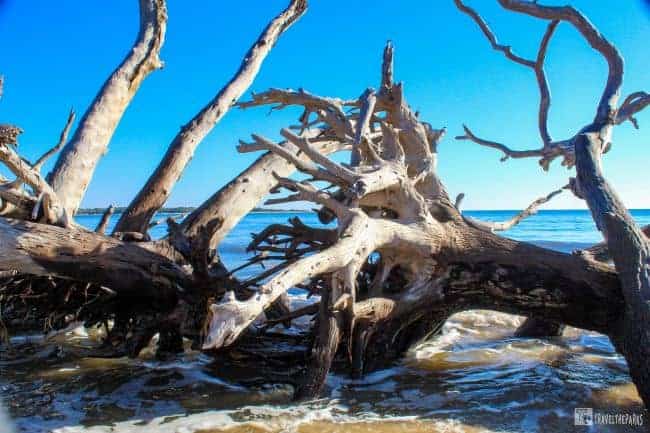





Janet l Schmidt
Any information as to why there are red “bricks” in the water at low tide? We have found very, very old gun shells and grapeshot here; we’re any battles fought here?
Travel the Parks
I am sure that skirmishes during the civil war happened all along the coast. Although we did not look for artifacts it should be noted that: The Florida Park Service warns that the use of a metal detector is prohibited in the park and removal of driftwood or artifacts from the park is also prohibited.